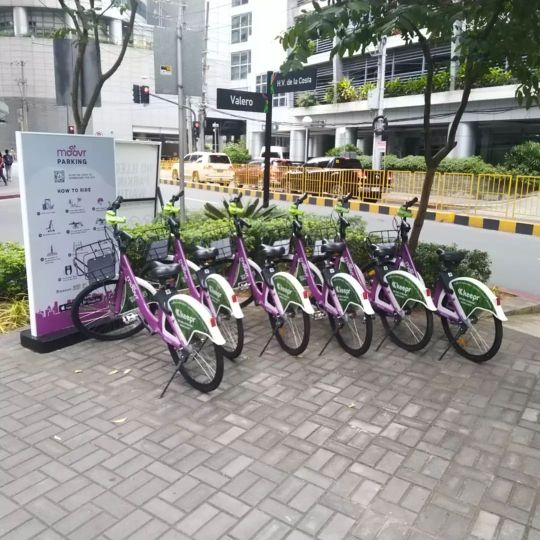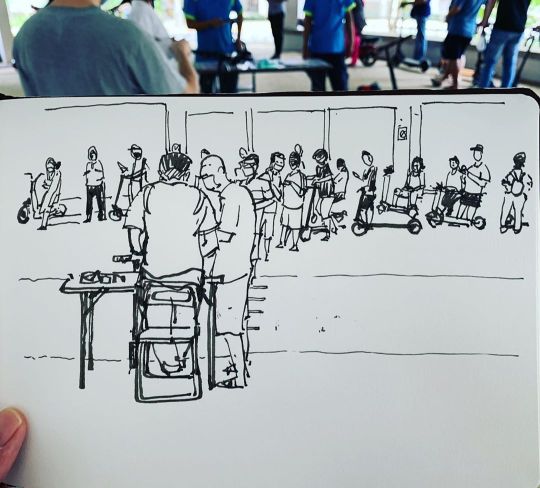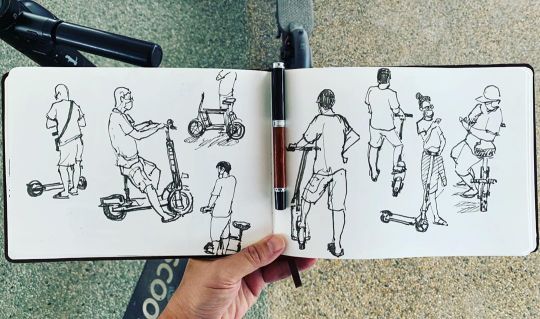#personalmobilitydevice
Explore tagged Tumblr posts
Text
Personal Mobility Devices Market Experiences Strong Growth Fueled By Demand For Independent Living Aids
The personal mobility devices market has witnessed rapid evolution over the past decade, driven by technological advancements, an aging global population, rising disability rates, and a growing demand for convenient transportation solutions. These devices include wheelchairs, mobility scooters, canes, crutches, and walkers, which help individuals with mobility impairments navigate their environments independently. The global demand is expanding, not only in developed regions but also in emerging economies, making this sector one of the most dynamic in the healthcare and assistive technology space.

Growth Drivers and Market Trends
One of the primary factors contributing to the market growth is the increasing geriatric population. According to the World Health Organization, the global population aged 60 years and older is expected to double by 2050, reaching over 2 billion. This demographic is particularly prone to mobility issues, driving the need for personal mobility aids.
Additionally, the rising prevalence of chronic diseases such as arthritis, osteoporosis, and multiple sclerosis further fuels the demand. With more individuals living longer but with physical limitations, assistive mobility devices become critical tools for improving quality of life and independence.
Technological innovation is another major trend. Companies are increasingly investing in smart mobility solutions, including electric and AI-enabled devices that offer features such as automated movement, fall detection, GPS tracking, and remote monitoring. These features enhance user safety, comfort, and overall experience.
Another notable trend is the shift toward lightweight and foldable devices. Consumers are looking for mobility aids that are portable, easy to store, and suitable for travel. This has prompted manufacturers to develop compact and ergonomic designs using lightweight materials such as carbon fiber and aluminum.
Regional Insights
North America currently leads the market, thanks to a combination of advanced healthcare infrastructure, strong reimbursement policies, and a large aging population. The U.S. in particular sees significant usage of powered mobility devices like electric wheelchairs and scooters.
Europe follows closely, with countries like Germany, the UK, and France investing in elderly care and disability support systems. Meanwhile, Asia-Pacific is the fastest-growing region, driven by rapid urbanization, increasing health awareness, and improved healthcare access in countries like China, Japan, and India.
In developing regions, although the market is smaller, awareness and accessibility are rising. Governments and non-governmental organizations are working to provide cost-effective mobility solutions to underserved populations.
Competitive Landscape
The personal mobility devices market is highly competitive, with both established players and startups competing on innovation, pricing, and service. Key players include Invacare Corporation, Sunrise Medical LLC, Drive DeVilbiss Healthcare, Pride Mobility Products Corp, and Permobil AB. These companies are focusing on expanding product portfolios and improving customer support services.
Mergers, acquisitions, and partnerships are common strategies employed to gain a competitive edge. Moreover, investment in research and development is vital, as companies strive to launch next-generation devices that cater to evolving consumer needs.
Challenges and Opportunities
Despite promising growth, the market faces certain challenges. Affordability remains a major concern, especially in low-income populations. High-end powered devices can be cost-prohibitive for many individuals, limiting adoption. There is also a lack of skilled personnel for maintenance and repair in some regions.
However, these challenges present opportunities for innovation. Companies that can offer affordable, durable, and customizable devices have the potential to disrupt the market. Furthermore, the rise of e-commerce platforms has made it easier for consumers to access a wider range of products, increasing competition and encouraging competitive pricing.
Healthcare policy changes and government initiatives to promote independent living among the elderly and disabled population are also expected to support market expansion. Subsidies, insurance coverage, and awareness campaigns can significantly boost adoption rates.
Future Outlook
The future of the personal mobility devices market looks promising. As technology advances and societal focus on accessibility and inclusivity grows, mobility solutions will become more integrated, intelligent, and user-friendly. With global efforts to improve healthcare access and support aging populations, the industry is poised for sustained and substantial growth.
#PersonalMobilityDevices#MobilityDevices#MobilityAids#AssistiveTechnology#HealthcareInnovation#MedicalDevices
0 notes
Photo

Moovr Bicycle Parking at McDonald's Valero branch #NewsMediaNest #moovr #bicycle #parking #mcdonalds #personalmobilitydevices #subscription (at Mcdonald’s Valero Street, Makati City) https://www.instagram.com/p/CWiuuqUvrWb/?utm_medium=tumblr
0 notes
Photo

So much trash... PMDs to be exact. I took advantage of the free PMD disposal scheme yesterday. Never have I seen so many e-Scooters in one small area before! New changes means new doors will be opened. New video: https://youtu.be/Va3ZO0JLOck . . . . . . . #dailysketch #sketch #phase2 #sketchbook #sketchbookskool #ink #illustration #linedrawing #sketchingpeople #grateful #urbansketchers #escooter #urbansketchersg #pmddisposal #sgartist #sketchwalker #sketchingtrash #sketchcollector #素描 #スケッチ #스케치 #alfdoodles #alvinmark #alvinmarksketchbook #personalmobilitydevice (at Tampines, Singapore City) https://www.instagram.com/p/CB-B0AxHzby/?igshid=i0l4861wan1g
#dailysketch#sketch#phase2#sketchbook#sketchbookskool#ink#illustration#linedrawing#sketchingpeople#grateful#urbansketchers#escooter#urbansketchersg#pmddisposal#sgartist#sketchwalker#sketchingtrash#sketchcollector#素描#スケッチ#스케치#alfdoodles#alvinmark#alvinmarksketchbook#personalmobilitydevice
2 notes
·
View notes
Photo

Think we need to custom make a luggage for ImmotorGO. 🤔 #immotorgo #madeforcities #mobilityforcities #urbantransport #personalmobilitydevice #electricscooter #superbattery #travellife #foodtrip
#travellife#superbattery#foodtrip#urbantransport#electricscooter#mobilityforcities#personalmobilitydevice#immotorgo#madeforcities
0 notes
Text
Participants needed for online survey! Topic: "Exploration of Mobility Scooter Use And Safety: They're Safe, Right?" https://t.co/Y60MnRdgsK via @SurveyCircle#MobilityScooter #MotorisedMobilityDevice #PersonalMobilityDevice #escooter #survey #surveycircle pic.twitter.com/Z4mOZoSGhX
— Daily Research (@daily_research) October 17, 2019
0 notes
Photo

This thing has done wonders for my core! #PersonalMobilityDevice - @segway #ninebot #minipro - #hoverboard, only much better control!!! #qualityproduct
1 note
·
View note
Photo

IO HAWK Intelligent Personal Mobility Device – This intelligent personal mobility device brings a fun element to the way you see, move, and connect with the world. The IO HAWK reaches a top speed: of 6.2 MPH and is operated by simply shifting your weight forward on the foot grips. It takes under 5 minutes to get familiar with IO HAWK and 30 minutes to master...
1 note
·
View note
Text
Personal Mobility Devices Market Witnesses Innovation Boost from AI Integration and Sustainability Trends
The Personal Mobility Devices (PMDs) market has witnessed significant growth in recent years, driven by increasing awareness of mobility challenges, an aging population, and advances in assistive technologies. These devices—which include wheelchairs, mobility scooters, walkers, and canes—play a crucial role in enhancing the independence and quality of life for individuals with mobility impairments.

As global demographics shift, the demand for PMDs continues to grow. According to the World Health Organization (WHO), by 2050, one in six people in the world will be over the age of 65. This demographic change, particularly in developed nations, is one of the most influential factors boosting the PMDs market. Older adults are more likely to experience mobility limitations, necessitating the use of supportive equipment.
Technological innovation has been a major catalyst in reshaping the landscape of PMDs. Manufacturers are increasingly integrating smart features such as GPS tracking, automatic braking systems, foldable designs, and IoT-enabled diagnostics. These enhancements not only improve user safety but also attract a younger demographic of users recovering from injuries or managing chronic conditions.
In terms of product types, the market is broadly categorized into wheelchairs (manual and powered), mobility scooters, canes, crutches, and walkers. Among these, powered wheelchairs and scooters are gaining traction due to their ease of use and improved maneuverability. Meanwhile, traditional devices like walkers and canes remain essential for their affordability and simplicity.
The geographical spread of the PMDs market varies significantly. North America and Europe dominate due to well-established healthcare systems, government support, and high levels of public awareness. The United States, in particular, has seen a surge in demand due to the implementation of Medicare policies that cover many assistive devices. Europe’s aging population, especially in countries like Germany and Italy, also supports continued market expansion.
However, the Asia-Pacific region is emerging as the fastest-growing market, propelled by rising healthcare expenditure, improving infrastructure, and growing elderly populations in countries like Japan, China, and South Korea. Japan leads the way in terms of innovation and adoption, with a strong focus on robotics and autonomous mobility aids.
While the market offers promising opportunities, it also faces several challenges. High costs of advanced PMDs and limited reimbursement options in some countries can restrict access for lower-income individuals. Furthermore, the lack of standardized safety regulations across regions poses a risk to both users and manufacturers. Addressing these challenges requires collaboration between governments, healthcare providers, and manufacturers to develop inclusive policies and improve device affordability.
COVID-19 also impacted the PMDs market. Initially, there was a slowdown due to supply chain disruptions and limited access to healthcare services. However, the pandemic highlighted the importance of mobility and independence for vulnerable populations, ultimately renewing interest and investment in personal mobility technologies.
Looking ahead, the PMDs market is expected to continue expanding, driven by both demand-side and supply-side factors. From a demand perspective, increased life expectancy, prevalence of disabilities, and rising lifestyle-related conditions such as obesity and arthritis contribute to the growing need for mobility aids. From the supply side, advances in materials, electronics, and AI integration are opening new possibilities for personalization, automation, and comfort.
Sustainability is also becoming an important consideration in the design and production of PMDs. Companies are exploring eco-friendly materials and energy-efficient systems, especially for powered devices. Modular and recyclable components are being integrated to reduce environmental impact, aligning with global sustainability goals.
In conclusion, the Personal Mobility Devices market is evolving rapidly, fueled by demographic trends, technological innovation, and shifting consumer needs. With the right combination of affordability, accessibility, and innovation, PMDs can continue to transform the lives of millions of individuals around the world. As stakeholders work to overcome existing challenges, the market is well-positioned for sustained and inclusive growth.
0 notes
Photo

When I went to dispose my escooter, there must have been 80 others during the 75 min block when I was there. There were 2 other disposal centres on the island that morning. Good bye, my time saver! ❤️🛴 . Video: https://youtu.be/Va3ZO0JLOck . . . . . . . #notjustme #dailysketch #sketch #phase2 #sketchbook #escooter #sketchbookskool #ink #illustration #linedrawing #sketchingpeople #grateful #urbansketchers #escooter #urbansketchersg #pmddisposal #sgartist #sketchwalker #sketchingtrash #sketchcollector #素描 #スケッチ #스케치 #alfdoodles #alvinmark #alvinmarksketchbook #personalmobilitydevice (at Tampines, Singapore City) https://www.instagram.com/p/CCDwZX3Hmiu/?igshid=gcp4vucxcpps
#notjustme#dailysketch#sketch#phase2#sketchbook#escooter#sketchbookskool#ink#illustration#linedrawing#sketchingpeople#grateful#urbansketchers#urbansketchersg#pmddisposal#sgartist#sketchwalker#sketchingtrash#sketchcollector#素描#スケッチ#스케치#alfdoodles#alvinmark#alvinmarksketchbook#personalmobilitydevice
0 notes
Photo

Never have I seen so many e-Scooters in one area. Time to dispose all non-UL2272 certified PMDs. If you’re watching the video, be sure to tune in to the last part. . Video: https://youtu.be/Va3ZO0JLOck . . . . . . . #dailysketch #sketch #phase2 #sketchbook #escooter #sketchbookskool #ink #illustration #linedrawing #sketchingpeople #grateful #urbansketchers #escooter #urbansketchersg #pmddisposal #sgartist #sketchwalker #sketchingtrash #sketchcollector #素描 #スケッチ #스케치 #alfdoodles #alvinmark #alvinmarksketchbook #personalmobilitydevice (at Tampines, Singapore City) https://www.instagram.com/p/CCBQxZcnZM0/?igshid=1u5xnxi4lsm8g
#dailysketch#sketch#phase2#sketchbook#escooter#sketchbookskool#ink#illustration#linedrawing#sketchingpeople#grateful#urbansketchers#urbansketchersg#pmddisposal#sgartist#sketchwalker#sketchingtrash#sketchcollector#素描#スケッチ#스케치#alfdoodles#alvinmark#alvinmarksketchbook#personalmobilitydevice
0 notes